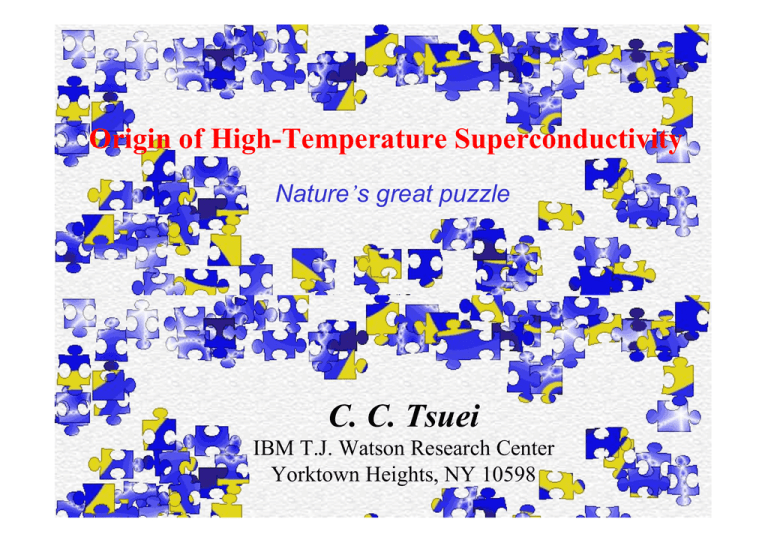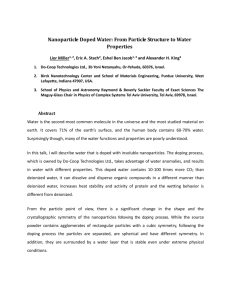C. C. Tsuei Origin of High-Temperature Superconductivity Nature’s great puzzle
advertisement

Origin of High-Temperature Superconductivity Nature’s great puzzle C. C. Tsuei IBM T.J. Watson Research Center Yorktown Heights, NY 10598 Basic characteristics of superconductors: • Perfect electrical conduction Kamerlingh Onnes (1911) capacity of carrying an electrical current without energy loss R = 0 , if T < TC and J < JC . • Perfect diamagnetism W. Meissner and R. Ochsenfeld (1933) ability to expel a magnetic field if H < HC The discovery of low-temperature superconductors Heike Kamerlingh Onnes (1911) The discovery of high-temperature superconductors (HTS) Bednorz and Mueller (1986) The Meissner effect: T < Tc T > Tc BCS Theory of Superconductivity Phys. Rev. 108, 1175 (1957). The Nobel Prize in Physics 1972 John Bardeen Leon Neil Cooper The BCS pairing glue in conventional superconductors: Phonon-mediated attractive interaction between electrons John Robert Schrieffer BCS Theory: How to glue the electrons into pairs against their Coulomb repulsion? Classical analogy: hard balls rolling on a spring mattress. QM description: Below Tc, electrons are bound into Cooper pairs(bosons) of anti-parallel spins. Energy gap: a finite amount of energy is required to break the pair. Δ(T) > 0, T < Tc Any number of these pairs could have the same energy state (bosonic condensation). This macroscopic quantum coherent state can be described by: BCS pair wave function, The normal state in cuprate superconductors is definitely not normal !! Outstanding issues to be settled: origin of pseudogap preformed Cooper pairs Phase diagram of cuprate superconductors nanometer scale charge inhomogeneity electron doping hole doping from a non-FL to FL behavior) ----- T. Timusk and B. Statt, Rep. Prog. Phys. 62, 61 (1999). A. Damascelli, Z. Hussain and Z-X Shen Rev. Mod. Phys. 75, 473 (2003). T* T* TN TN AFM doping effect (doping-induced evolution TEMPERATURE anomalous transport properties AFM Tc d- SC Tc ? d- SC 0 CHARGE CARRIER CONCENTRATION The superconducting state: Tricrystal geometry d-wave pairing symmetry has been observed in both electron- and hole-doped cuprate superconductors. Scanning SQUID microscope image The d-wave pair state is robust against TRSB, and a large variation in temperature and doping. Experiments probing the nature of nodal excitations in 2D d-wave superconductors support BCS in the context of the FL formalism. No consensus on the microscopic pairing mechanism. Contenders include: • superexchange interaction • AF magnetic fluctuations • phonons C.C. Tsuei et al., PRL 73, 593 (1994) C.C. Tsuei and J.R. Kirtley, Rev. Mod. Phys. 72, 969 (2000) Origin of High-Temperature Superconductivity Nature’s great puzzle How to piece together the puzzle? pick the right pieces!! Key findings about HTS: • 2D layered structure, strongly correlated electron systems • doping effects (on Tc , ns , - - - - ) • d-wave pairing symmetry • anomalous normal state (T*, ρ, RH , - - - ), d-wave like pseudogap in the single particle excitation spectrum below T* • doping-dependent isotope effects • nano-scale C4v symmetry-breaking in electronic structure • ---- An example of the high-temperature superconductors: (YBCO) Tc ~ 100K Note: Cu-O square lattice with Cu-O-Cu buckling bonds Symmetry Breaking and Order Parameter Big Bang, Parity Nonconservation Ferromagnetic Phase transitions Superconducting Full Symmetry Group: G Symmetry Breaking H, H G Order Parameter: a measure of the amount of symmetry breaking SUPERCONDUCTIVITY A state of spontaneously broken symmetry T > Tc: G = Gxtl x Rspin x U(1) crystal spin rotation x T gauge time reversal T < Tc: The global gauge symmetry U(1) is always broken. Group-theoretic notation Order parameter basis function Wave function name Schematic representation of ∆(k) in B.Z. A1g A2g B1g B2g constant xy(x 2-y 2) x 2-y 2 xy s-wave g dx 2- y 2 dxy ky + + kx + + + + + + Conventional superconductors: s-wave, only U(1) broken at Tc Unconventional superconductors: such as d-wave OP has nodes (∆ = 0 on FS) ∆(k) changes its sign as a function of k Phase-sensitive test for a definitive determination of pairing symmetry Phase-sensitive experiment: Pair tunneling + Flux quantization I s = − I c sin ∆ϕij = I c sin ( ∆ϕij + π ) Φa + Is L + Φ 02 U ( Φ, Φ a ) = 2π SC loop containing Josephson jns. Ic ∝ ΨiΨ ∝ e * j ( i ϕi −ϕ j ) Φ0 ∑ ∆ϕij = nΦ 0 2π ij 0-loop Φ + Φ 2 L I 2πΦ c a cos − + θ ; θ =0, π Φ 0 Φ 0 πΦ 0 even number of sign changes odd in Is 0 integer flux quantization π ½ integer As a function of the loop geometry, the presence and absence of the ½ Φo effect can be used for probing the phase of the order parameter, ∆(k). Techniques for observing the ½ Φo effect: SQUID interferometry: Wollman, van Harlingen et al. (1993). Brawner & Ott (1994), Mathai, …Welstead (1995). Josephson jn modulation: Wollman, van Harlingen et al. (1995). Miller et al. (1995), Iguchi and Wen (1994) Tricrystal magnetometry: Tsuei, Kirtley et al. (1994) B Bulaevskii, Kuzii & Sobyain (1977). Geshrenbein, Larkin & Barone (1987). Sigrist & Rice (1992) π π-loop Tricrystal geometry Scanning SQUID Microscope Images C. C. Tsuei et al., PRL 73, 593 (1994) J.R. Kirtley et al., PRL 76, 1336 (1996) YBCO epitaxial film 4.2 K • effect of disorder at the gb junction interface was taken into consideration • a yes or no pairing symmetry test. • well – adapted for testing the gap symmetry of various cuprate superconductors, and especially the doping dependence of a particular cuprate system. C.C. Tsuei and J.R. Kirtley, Rev. Mod. Phys. 72, 969 (2000) The original tricrystal experiment was repeated and confirmed by A. Sugimoto et al. Physica C 367, 28 (2002). Bi2Sr2CaCu2O8 J.R. Kirtley, C.C. Tsuei, H. Raffy, Z.Z. Li, A. Gupta, J. Z. Sun, S. Megert, Europhys. Lett. 36, 707 (1996). Tricrystal pairing symmetry tests of electron doped cuprates Nd1.85Ce0.15CuO4-y C.C. Tsuei and J.R. Kirtley, PRL 85, 182 (2000) Doping Dependence of Pairing Symmetry Tc=Tc,max[1-82.6(p-0.16)2], M.R. Presland et al. Physica C 176C, 95 (1991). Crystal Structure and Allowed Pair States In YBCO CuO2 layer double CuO2 planes plus Cu-O chains CuO2 layer CuO chains CuO2 layer CuO2 layer M. Walker, J.L-Strathmann PRB 54, 588 (1996) K. Kouznetsov et al. PRL 79 3050 (1997) θ2= − 17º (a) 400µm YBa2Cu3O7-δ (b) 150µm (c) a-axis -22.5° θ2 Nb Ramp-edge tunnel junctions θ2=332º



